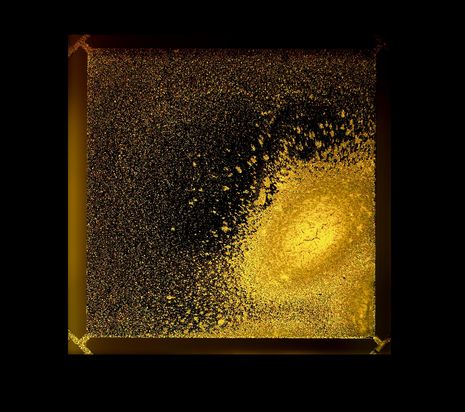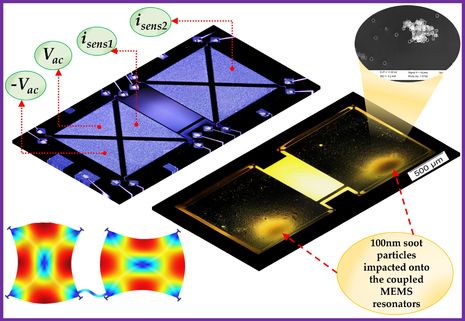Cambridge Spotlight: MEMS chip technology all set to tackle air pollution
The first ever article of our Cambridge Spotlight Series features the work of Malar Chellasivalingam, who describes how Cambridge’s Department of Engineering is using MEMS technology to combat air pollution.

Human use of fire was perhaps the first anthropogenic source of air pollution. But industrialization has escalated air pollution levels by increasing the emission of ultra-fine particles into the air. These ultra-fine particles are normally less than 100 nanometres in diameter and are often emitted by industrial emissions, exhaust plumes in aircraft engines, diesel engines, automobile exhausts, smoke, and so forth.
Research conducted in rats has shown that these ultra-fine particles are so tiny that if they are inhaled, there are chances of them getting translocated across the blood-brain barrier in certain brain regions, which implies significant health effects for humans. Exacerbating the situation, climate change due to the warming planet tends to trap the emitted ultra-fine particles not only in densely populated economies like China and India but also in Europe and other wealthy countries.
The WHO suggests that by reducing the emission of ultra-fine particles, the public risk to health conditions including stroke, lung cancer, heart diseases, and respiratory diseases such as asthma would be significantly reduced. Supporting this statement, the statistics also show that these ultra-fine particles are responsible for about 7 million premature deaths a year.
“There is no silver bullet for avoiding air pollution due to the ultra-fine particles, but the only real answer in the long term is to tackle it at its source.”
There is no silver bullet for avoiding air pollution due to the ultra-fine particles, but the only real answer in the long term is to tackle it at its source. This is partly because the ultrafine particles have several sources including dust, cigarette or tobacco smoke, soot or fumes in car exhaust, exhaust plumes in aircraft engines, power plants, and so forth. In effect, the U.S. Environmental Protection Agency — as one of the measures to regulate the particle emission sources — has set stringent tailpipe emission standards for diesel engines that emit these ultra-fine particles. Not only in the US but also in the UK, where diesel trains are asked to be replaced by 2040.
Consequently, the current engine emissions or air-quality standards that have been set are mass-based and this, in turn, has accelerated the demand for sensors that could estimate the mass of these emitted ultra-fine particles. Existing light-based commercial technologies could only trace the emission of these particles down to 300 nanometres. The result? Giant automotive companies like Volkswagen were easily able to hoax their emission tests, for instance, in the US.
We, at the Cambridge University Engineering Department are exploring the potential of MEMS (Microelectromechanical Systems) Technology to implement miniaturized smart sensors for tracing the emission of these ultra-fine particles from their sources in real-time. The data obtained from the smart micro-sensors could then be used to make decisions, monitor and regulate the ultra-fine particle emission sources leading to air pollution.

While the existing light scattering-based technologies need to rely on particle size and morphology for counting the number of particles, the MEMS sensors could form a good alternative as they could estimate the mass of the particles directly. The MEMS sensors when used as mass balances could take the particle detection below the 300 nanometres size limit, due to their high sensitivity to mass changes. The MEMS sensors originally vibrate at their resonant frequency and once when the nano-sized particles touch the surface of the micro-sized MEMS sensors, the vibrating movement or the resonant frequency of the sensors change which then provides information about the mass of the nanoparticles.
“While the existing light scattering-based technologies need to rely on particle size and morphology for counting the number of particles, the MEMS sensors could form a good alternative as they could estimate the mass of the particles directly.”
In the Engineering Department, we have designed highly sensitive MEMS resonators, which when employed as particulate mass sensors, would enable a true mass measurement independent of the particle size and density. We have improved the sensitivity of the existing MEMS sensors by adopting Cambridge’s Nobel Prize-winning (1977) concept of “electron eigenstates in a disordered solid may become localized resulting in limited metallic conduction” into the MEMS technology, which has resulted in about 3 orders of magnitude improvement in sensitivity.
We have implemented these highly sensitive MEMS resonators for sensing diesel soot particles that are modeled based on soot particles generated from combustion processes in a flame burner. We have also estimated from our initial measurements that this highly sensitive MEMS sensor is insensitive to the temperature which means that the effects of temperature in the measured signal could be eliminated, which then is a major advantage for us. These MEMS sensors could also help in miniaturizing the size of the instrument, thereby providing a route towards the reduced cost and portable system for monitoring the real-time emission of ultra-fine particles. We need to further integrate these MEMS sensors with microfluidics to minimize the size of the instrument but the fundamentals – high sensitivity, good resolution and good stability required for long-term particle measurements – are already there. It is a critical step forward in the future development of the sophisticated systems that we need in order to deliver truly smart micro-sized sensors, for monitoring the particle emission sources in real-time.
One of the current challenges that limit these MEMS sensors from field deployment is automated cleaning of the sensor such that the sensor surface could be regenerated once when it is filled with particles. The MEMS sensors lose their lifetime when the sensor surface is filled with ultra-fine particles that are collected. Nevertheless, the highly sensitive MEMS sensor that we have designed has two resonators weakly coupled to each other such that periodic switching can be performed for collecting these ultra-fine particles. This, in turn, eliminates the need for extracting the sensor out of the instrument for cleaning and would enable the sensor lifetime.
In addition, atmospheric science experts such as Alastair Lewis and Peter Edwards have called on researchers to validate the accuracy of the air-pollution sensors, since a questionable accuracy of the sensor data would lead to inefficiencies in air quality regulations, which are instituted based on the data obtained from these sensors.
Currently, in the Engineering Department, we are involved in establishing the accuracy of the obtained MEMS sensor measurements by accounting for limiting factors that introduce inconsistencies in the signal measurements.
We anticipate that the field deployment of our MEMS sensors would be realized in the near future!
 Comment / Plastic pubs: the problem with Cambridge alehouses 5 January 2026
Comment / Plastic pubs: the problem with Cambridge alehouses 5 January 2026 News / Cambridge businesses concerned infrastructure delays will hurt growth5 January 2026
News / Cambridge businesses concerned infrastructure delays will hurt growth5 January 2026 News / New movement ‘Cambridge is Chopped’ launched to fight against hate crime7 January 2026
News / New movement ‘Cambridge is Chopped’ launched to fight against hate crime7 January 2026 News / AstraZeneca sues for £32 million over faulty construction at Cambridge Campus31 December 2025
News / AstraZeneca sues for £32 million over faulty construction at Cambridge Campus31 December 2025 News / Uni-linked firms rank among Cambridgeshire’s largest7 January 2026
News / Uni-linked firms rank among Cambridgeshire’s largest7 January 2026









